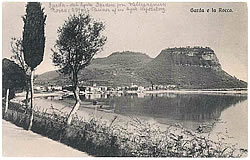 Its
origins Its
origins
The Garda desert originates from the dry bed of Lake Garda (or
Benàco): the largest Italian lake until the first half of
the XXI century.
Lake Garda was an important Italian tourist destination and is
cited in a number of literary works by great authors such as Gaio
Valerio
Catullo, Dante Alighieri and J.W. v. Goethe.
Until the first decade of the year 2000 the native population
of Garda and Italy itself 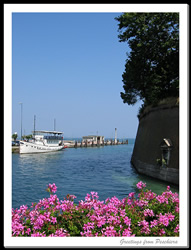 ignored
the importance and the gravity of the water shortage emergency
(the first indication of desertification),
the first warnings being recorded around the year 2003. ignored
the importance and the gravity of the water shortage emergency
(the first indication of desertification),
the first warnings being recorded around the year 2003.
The causes of this ecological and geological upheaval are still
today a subject for discussion, but many climatologists and historians
agree in identifying two main causes:
• the greenhouse effect;
• the destruction of the natural and water eco-systems of Garda;
It is important to note that these causes were totally ignored until 2010.
In fact, many historians agree that one of the main accomplices of this catastrophe
was the ignorance of the local population. All the elements were in fact
present to permit 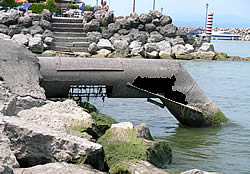 the
identification of a series of water shortages as early as the first
decade of 2000, but often the lowering of the lake’s water
level was accepted because rainfall would have raised the capacity
to provide water again. The same chronicles record continuous and
futile squabbles between the local administrations for the use
of the little water that was left, without ever undertaking any
real collective action. the
identification of a series of water shortages as early as the first
decade of 2000, but often the lowering of the lake’s water
level was accepted because rainfall would have raised the capacity
to provide water again. The same chronicles record continuous and
futile squabbles between the local administrations for the use
of the little water that was left, without ever undertaking any
real collective action.
In reality all of this resulted in not focusing on the real reason
for the water shortage, in other words the continual extinction
of the ice caps (caused by the greenhouse effect) of the Brenta
Group mountain range which originally created the Sarca valley
and the lake’s main inlets.
The theory which attributes the concomitant cause of the phenomena
of desertification to the indifference of the population is confirmed
by the following historical sources:
- Water dissipation above 30% in some aqueducts in the neighbouring
municipalities (including those in the area which was then called “lower
lake/ higher Mincio river” of Mantova) because of obsolete
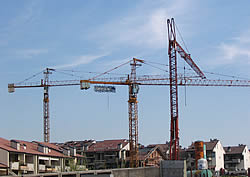 distribution networks; distribution networks;
- The data regarding local pollution levels: in fact Verona
was one of the 3 most polluted cities in Italy (data item of
2006);
- A vertiginous increase in real
estate speculation (often defined
as being “savage” [1] - [2] - [3] - [4]) which led to the rapid extinction
of both agricultural land and the greenery surrounding the lake
in favour of residential and tourist structures (with a total
breakdown in the centuries old water canalization system and
the consequent waste and dissipation of the aquifers);
- A total
indifference to alternative (and/or ecological) transport means
in favour of automobiles and other wheeled vehicles (the
different Lake/Verona areas – areas with high density tourism – lacked
evening and night-time transportation connections); this indifference
is also evidenced by the continual road-works (motorways, dual
carriageways, car parks) and the consequent building industry
activity attracted by these road conditions.
The lake had already retracted hundreds of metres by the beginning
of 2012, leaving new areas with hectares of beach and land; this
was an opportunity that the unscrupulous Italian construction companies
did not hesitate to financially exploit. In a short space of time,
however, the disadvantages of what was later defined an environmental
disaster of national proportions were seen to be superior to the
profit levels attained.
The first marked exodus from the lake took place around 2019 when
the level of the water fell circa 15 metres. In any case, by then
the area between Verona and Brescia had become a single residential
centre which joined together the municipalities of Bussolengo,
Castelnuovo, Peschiera, Desenzano and Lonato (a total urban extension
of 90 Km).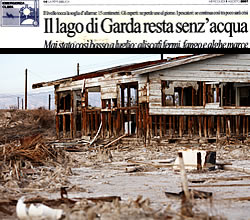
The population which had previously moved to this area from Milan
started moving again into areas further north, such as the Trentino
province (it is believed that this is the main cause of the second
secessionist crisis 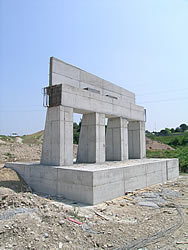 of
the Alto Adige region). of
the Alto Adige region).
The final extinction of the lake ocurred around 2035 – 2045,
and the formation of the first dunes date back to a few years later.
As fate would have it, if Lake Garda was a refuge for the population
(of Italian origin) which was abandoning the by now unliveable
city of Milan, in a similar way 60 years later the Garda Desert
became the home of the largest Afro-Asian-Italian community, created
by the new generations which came from northern Italy’s large
capital.
The Garda Desert has a maximum length of 52 Km, a width of 17
Km and a maximum depth of 180 metres below sea level.
|
